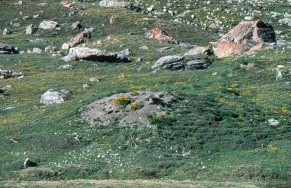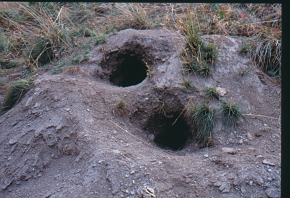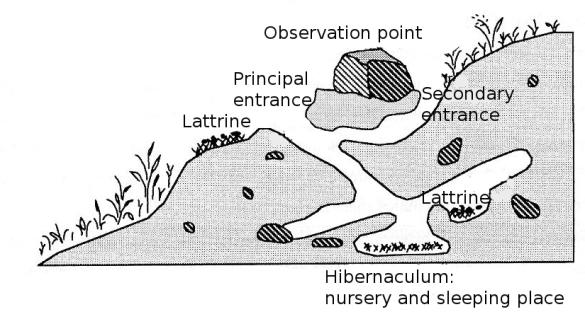Social Organization
A family life
The alpine marmot has a complex social structure compared with other members of the Sciuridae family, which includes marmots, squirrels, chipmunks and prairie dogs (Blumstein and Armitage 1997).

The social structure of the alpine marmot is based on the family group. A typical family group consists of: one dominant adult couple; a variable number of subordinate adults of both sexes (individuals at least two years old); juveniles (marmots one to two years old); and pupsof the year (less than one year old) (Perrin 1993; Perrin et al. 1993). In the dominant pair, the male and female seem to be equal, with neither one exerting power over the other.
Interactions among members of a family group are numerous and friendly, and help maintain the cohesiveness of the group (Perrin 1993; Perrin et al. 1993). Each family member interacts with all the other individuals in the family, with the dominant male interacting less than other members. When aggressiveness occurs, it is almost always between two individuals of the same sex competing for dominance and territory.
Individuals in a family group are usually related to one or both of the two dominant individuals, but not always (Perrin 1993; Perrin et al. 1993). If the dominant male or female changes, some family members may no longer have a kinship link to the dominant couple. Much more rarely, an unrelated adult may be integrated into an existing family group (Giboulet 2000).
On its territory

All individuals in the family group share a common territory whose boundaries remain the same from year to year. The size of a territory on average is 2.5 ± 0.53 ha [6.2±1.3 acres], and varies between 0.9 ha and 2.8 ha [2.2 acres and 6.9 acres] (Perrin et al. 1993). The area includes a main burrow (M), side burrows (S) and latrines.
The main burrow (M) consists of several interconnected rooms, with several entrances/exits to the outside. All individuals in the same family group return to the burrow during periods of inactivity, such as to spend the night and to hibernate. Also, the burrow serves as a nursery where the female gives birth and nurses the babies until they emerge from the burrow at about six weeks.
Secondary burrows (S) are small excavations, rarely more than six feet (two meters) deep, with only a single entrance/exit. These burrows mainly serve as refuges against potential predators.
 |
 |

Although subordinate individuals help guard their family’s territory, only the dominant pair seems to actively defend against intruders (Arnold et Dittami 1997). To discourage intruders, all family members leave scented secretions near the major burrows, with the scents of the dominant pair being the most important. The secretions of the dominant pair also mark the borders of the family’s territory (Bel et al. 1995; Bel 1998; Bel et al. 1999).
From the family to the colony

A group of family territories forms a colony. Within a colony, interactions between individuals belonging to different family groups are almost always antagonistic (Perrin 1993; Perrin et al. 1993).
Bibliography
Arnold W, Dittami JP (1997) Reproductive suppression in male alpine marmots. Animal Behaviour 53, 53-66.
Bel M-C (1998) Le marquage jugal chez la Marmotte Alpine (Marmota marmota Linné 1758): Aspects éco-éthologiques et étude du système de communication chimique. Thèse de doctorat, Université Claude Bernard, Lyon
Bel M-C, Porteret C, Coulon J (1995) Scent deposition by cheek rubbing in the Alpine Marmot (Marmota marmota) in the French Alps. Canadian Journal of Zoology 73, 2065-2071.
Bel M-C, Coulon J, Sreng L, Allainé D, Bagneres AG, Clément JL (1999) Social signals involved in scent-marking behavior by cheek-rubbing in alpine marmots (Marmota marmota). Journal of Chemical Ecology 25, 2267-2283.
Giboulet O (2000) Processus de colonisation et de sélection de l’habitat chez la Marmotte Alpine (Marmota marmota L. 1758). Thèse de doctorat, Université Claude Bernard, Lyon.
Blumstein DT, Armitage KB (1999) Cooperative breeding in marmots. Oikos 84, 369-382.
Perrin C (1993) Organisation socio-spatiale et distribution des activités chez la Marmotte Alpine (Marmota marmota Linné 1758). Thèse de doctorat, Université Denis Diderot, Paris.
Perrin C, Allainé D, Le Berre M (1993) Socio-spatial organization and activity distribution of the Alpine Marmot Marmota marmota: Preliminary results. Ethology 93, 21-30.
